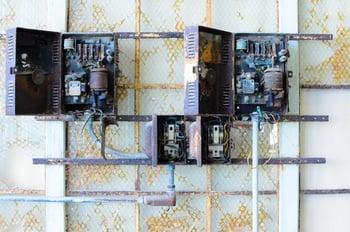 Many people choose the charm of older buildings over the cookie cutter look that some new developments offer. They like the old architectural features, and the quirks. What they probably do not like, or would not if they considered it, is old, potentially dangerous wiring. Let us face it – it is far more interesting to work in a building with a history than something that was slapped together with cinderblocks a handful of years ago.
Many people choose the charm of older buildings over the cookie cutter look that some new developments offer. They like the old architectural features, and the quirks. What they probably do not like, or would not if they considered it, is old, potentially dangerous wiring. Let us face it – it is far more interesting to work in a building with a history than something that was slapped together with cinderblocks a handful of years ago.
The problem is, wiring is not something you see unless you open up walls in most cases, and it may not be up to code, which means that most people who buy or rent in a historic commercial building have no idea they’re at risk until something goes wrong. Here is what could go wrong with old wiring, and how to limit the risk:
Knob and Tube Wiring
Knob and tube wiring was a popular type of wiring, often for residential buildings. However, with many of today’s commercial buildings having a history as residences and vice versa, you really never know what you are getting. Most knob and tube wiring out there is about eighty years old, and likely not in the best shape. If you are considering buying a commercial building from a bygone era, make sure that you get an electrical contractor to inspect the wiring, and make sure that you will not be facing the replacement costs.
What Happens to Old Wiring and Electrical?
Many people think that old wiring is bad just because people did not know what they were doing. That is not entirely true, and theoretically, many correctly installed antique electrical systems could hold up against modern electrical perfectly well – if it were not for rust, rot, rodents and wear and tear. All of those things add up, however, and result in numerous problems, including:
- Poor or missing insulation, which means potential exposure to live wires.
- Shorts that could potentially be fire hazards.
- Lack of or poor grounding.
In addition to these general problems, old wiring is sometimes not capable of running modern lighting, appliances, and computer systems. This can lead to overheating and fire hazards.
What Should You Do Before You Purchase a Historic Commercial Building?
If you are considering buying a historic commercial building, then it is critical that you have a detailed, in depth inspection of the electrical system before you make any decisions. Use a commercial electrical contractor who knows what to look for and where, and who can give you an estimate of the costs to replace old, potentially dangerous electrical and wiring.
Once you know what you are dealing with, there are two options: negotiate a drop in price from the owner, or accept that you will need to pay for the electrical replacement out of pocket. Because if you do decide to buy the building, leaving old wiring in place is just not a viable option.



